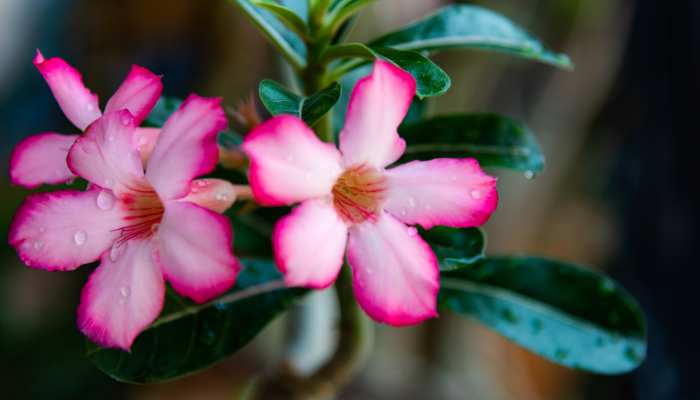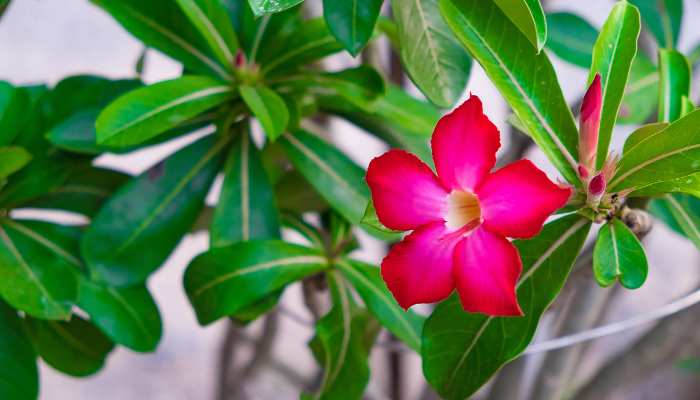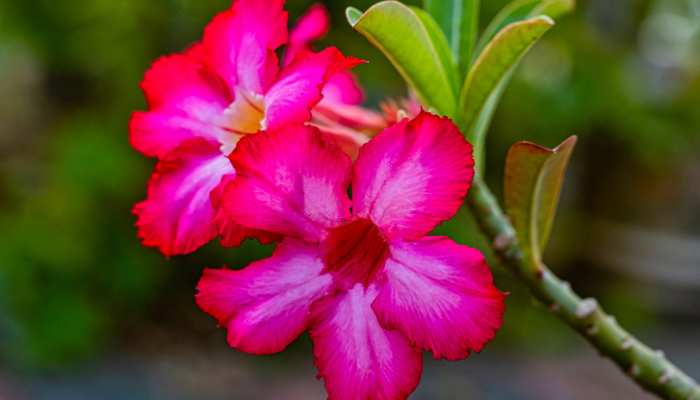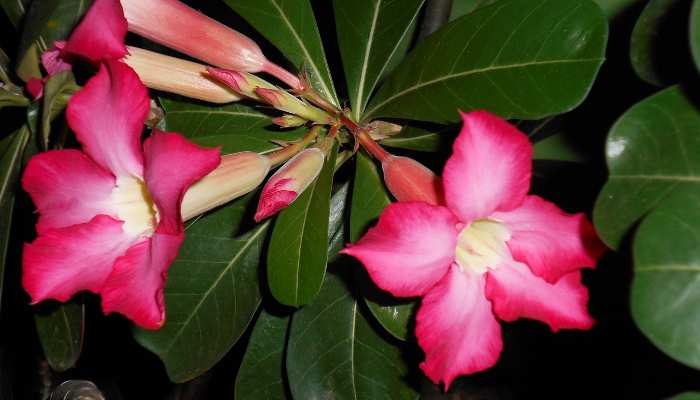If you are looking for Adenium Plants Care for your Garden this Blog Help You.
Introduction
Adenium plants, often called desert roses, are stunning succulents that add a touch of exotic beauty to any space. Because of their attractive flowers and unique caudex, these plants are a favorite among both novice and experienced gardeners.
But how do you care for these beauties to ensure they thrive? In this comprehensive guide, we’ll explore everything you need to know about adenium plant care, from choosing the right potting mix to managing pests and diseases.
Adenium Plants Care Table of Contents
1. Understanding Adeniums
Adeniums are native to arid regions of Africa and the Middle East, where they have adapted to thrive in hot, dry conditions.
Their unique swollen base, known as a caudex, stores water for periods of drought, making them well-suited for life in desert climates. These plants produce vibrant, trumpet-shaped flowers in shades of pink, red, white, and purple, adding a burst of color to their surroundings.
Key Points:
- Adeniums are succulent plants native to arid regions.
- They feature a swollen base called a caudex, which stores water.
- Adeniums produce striking trumpet-shaped flowers in various colors.

2. Selecting the Right Pot
When choosing a pot for your adenium Plants Care, opt for a container with good drainage to prevent waterlogging, which can lead to root rot.
Terra cotta pots are an excellent choice as they allow excess moisture to evaporate through the porous material. Ensure the pot is slightly larger than the plant’s root ball to accommodate growth but avoid oversized containers, as they can retain too much moisture.
Key Points:
- Select a pot with adequate drainage to prevent root rot.
- Terra cotta pots are recommended for their porous nature.
- Choose a pot slightly larger than the plant’s root ball.
3. Proper Watering Technique
Watering is crucial for adeniums, but overwatering can be detrimental. Allow the soil to dry out between waterings, and then thoroughly saturate it until water drains from the bottom of the pot.
During the dormant season, reduce watering frequency to mimic natural conditions. Always water the soil directly and avoid getting water on the leaves, as this can promote fungal diseases.
Key Points:
- Water adeniums thoroughly, allowing the soil to dry out between waterings.
- Avoid overwatering, especially during the dormant season.
- Water the soil directly to prevent fungal diseases.

4. Providing Adequate Light
Adeniums thrive in bright sunlight, so place them in a sunny spot where they can receive at least 6 hours of direct sunlight per day. Inadequate light can result in leggy growth and poor flowering.
If grown indoors, place your adenium near a south-facing window or supplement with grow lights to ensure they receive sufficient light.
Key Points:
- Adeniums require at least 6 hours of direct sunlight daily.
- Insufficient light can lead to leggy growth and reduced flowering.
- Place indoor adeniums near a south-facing window or use grow lights.
5. Fertilizing Your Adenium
To support healthy growth and abundant flowering, fertilize your adenium regularly during the growing season. Use a balanced fertilizer formulated for succulents and apply it at half-strength every 2-4 weeks. Avoid fertilizing during the dormant season, as adeniums Plants Care require minimal nutrients during this time.
Key Points:
- Fertilize adeniums regularly during the growing season.
- Use a balanced fertilizer for succulents at half-strength.
- Avoid fertilizing during the dormant season.

6. Pruning and Training
Pruning helps maintain the shape and size of your adenium while encouraging branching and flowering. Remove dead or damaged branches as needed, and pinch back new growth to promote bushiness. You can also train your adenium into a bonsai-like form by selectively pruning and shaping the branches.
Key Points:
- Prune adeniums to maintain shape and encourage branching.
- Remove dead or damaged branches and pinch back new growth.
- Train adeniums into bonsai-like forms through selective pruning.
7. Preventing Pests
Although adeniums are relatively resistant to pests, they can still fall victim to common garden nuisances such as aphids, mealybugs, and spider mites. Inspect your plants regularly for signs of infestation, and treat affected areas with insecticidal soap or neem oil. Maintaining good air circulation around your plants can also help deter pests.
Key Points:
- Inspect adeniums regularly for signs of pest infestation.
- Treat affected areas with insecticidal soap or neem oil.
- Promote good air circulation to deter pests.
Read More
8. Managing Common Diseases
While adeniums are hardy plants, they can be susceptible to fungal diseases such as root rot and powdery mildew, especially in humid conditions.
Avoid overwatering and ensure proper air circulation to prevent fungal issues. If disease does occur, treat affected areas with fungicides labeled for use on succulent plants.
Key Points:
- Prevent fungal diseases by avoiding overwatering and promoting air circulation.
- Treat fungal infections with appropriate fungicides.
- Monitor plants closely for signs of disease and take prompt action.

9. Propagation Methods
Propagation is an exciting way to expand your adenium collection and share your love of these plants with others.
Adeniums can be propagated from seeds, stem cuttings, or by grafting. Each method has its pros and cons, so choose the one that best suits your preferences and skills.
Key Points:
- Propagate adeniums from seeds, stem cuttings, or grafting.
- Each propagation method has its advantages and challenges.
- Experiment with different methods to find what works best for you.
10. Seasonal Adenium Plants Care Tips
Adeniums have specific care requirements depending on the season. During the growing season, provide ample sunlight, water, and fertilizer to support vigorous growth and flowering. In contrast, reduce watering and fertilizer during the dormant season to mimic their natural environment and prevent issues like root rot.
Key Points:
- Adjust care practices based on the season.
- Provide ample sunlight, water, and fertilizer during the growing season.
- Reduce watering and fertilizer during the dormant season.
11. Adenium Plants Care FAQs
1. How often should I water my adenium plant?
Water your adenium plant when the top inch of soil feels dry to the touch. During the growing season, typically spring and summer, water more frequently, and reduce watering in the dormant season to prevent root rot.
2. What kind of soil is best for adenium plants?
Adenium plants thrive in well-draining soil mixes that include ingredients like coarse sand, perlite, and gritty soil. Avoid heavy or water-retaining soils to prevent waterlogging and root rot.
3. How much sunlight does my adenium plant need?
Adenium plants require at least six hours of direct sunlight per day to thrive. Place them in a sunny location indoors or outdoors to ensure they receive adequate light for healthy growth and flowering.
4. How can I encourage my adenium plant to bloom?
To encourage blooming, provide ample sunlight, avoid over-fertilizing, and prune the plant to stimulate new growth. Balanced fertilizers formulated for succulents can be applied every 2-4 weeks during the growing season.
5. How do I prevent pests and diseases in my adenium plant?
Maintain good cultural care practices, such as proper watering and adequate sunlight, to keep adenium plants healthy and resilient against pests and diseases. Regularly inspect the plant for signs of pests or fungal infections, and treat them promptly with appropriate remedies such as insecticidal soap or neem oil.
















